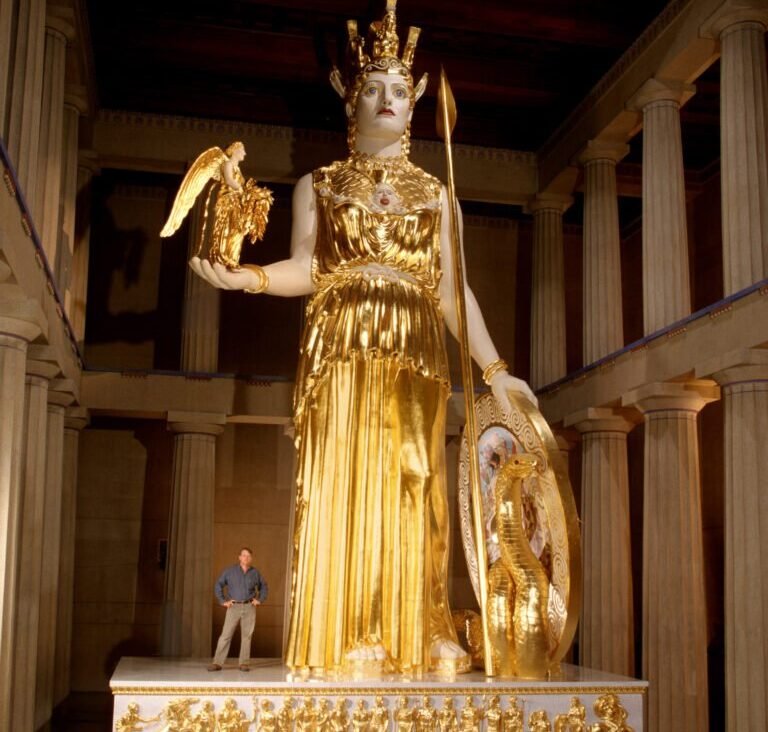Contenus
ToggleIn short
Arrhephoria was a festival among the Athenians, established in honor of Athena. The word is derived from the term Greek Ἀρρηφόρια, which is composed of ἀρρητον, “mystery”, and φέρω, “I carry”. This festival was also called Hersiphoria, from Herse, the daughter of Cecrops, in whose name it was established. Some modern followers of Hellenism choose to celebrate it on Skirophorion 3.

Arrhephoria, the two sacred women
On the Acropolis of Athens, two girls aged between seven and eleven were elected to live for a year at a time as arrhephoroi, tending the sacred olive tree and weaving, with the help of other women, Athena's new dress. The proud parents commemorated their daughters' service with dedications at the Acropolis. During the annual festival of Arrhephoria, the girls (according to Pausanias) placed on their heads what the priestess of Athena gave them to wear.
Neither the priestess nor the girls know what she is giving them. In the city there is a sacred enclosure not far from that of Aphrodite in the Garden and through it passes a natural underground passage. Here the virgins descend. At the bottom, they leave behind what they brought and take something else and carry it, veiled as it is. These two virgins were sent away immediately and others were taken to the Acropolis in their place.
The interpretation of the festival is difficult due to a lack of sources, but it is clear that the virginal arrhephoroi are chosen from among the noblest families of the city and are deployed in a context of impregnation (dew), sexual power ( Aphrodite and Eros), and birth (Erichthonios). The word "arrhephoros" probably etymologically means "dew-bearer", which at first glance doesn't help. The arrhephoroi were responsible for weaving peplos (clothing) for Athena. The aletrids ground grain for Athena. The arkios were the priestesses who celebrated a rite intended to forgive an offense committed against Artemis.
The kanephorai were the girls who carried the baskets with all the offerings to the festival. Kanephoros was a common place in rituals or festivals similar to Arrhephoria as it was a position of honor held in ancient Athens. Archaeological evidence reveals that near the Erechtheion, a secret staircase led from the Acropolis past a small rock-cut sanctuary of Eros and Aphrodite, near which was the enclosure to which they were traveling. The mythical associations of the arrhephoroi have the Erechtheion as their starting point.
In the 5th century BC. Aristophanes wrote Lysistrata which explained the stages of women during this festival:
For at seven years or less I became a girl priestess in the Erechthean temple of the Maid; And at ten o'clock on this hill I made flour at the mill. For the cakes that are presented to Notre-Dame, Then I went to the town of Brauron and put on a yellow dress. Walk in the procession like the bear; To complete my perfect score, I carried the sacred basket to Athena's feast when I was young and beautiful.
These stages have certain tasks that display the old system that all girls must follow when they reach puberty. The stages of this “initiation” are as follows. The Arrhephoroi comes first, and it is a moment when the girl dresses in white and begins to weave for the offering to Athena.
It is an art which was frequently practiced by women at the time, and which must therefore be taught from a very young age. The second step is to teach the girl how to bake, more precisely, how to make bread. The third stage is considered a symbol of death and resurrection. The girl must attend and participate in the festival with the older women. These milestones are all tasks that the girl will use for the rest of her life, and are therefore held with great importance and expectation.
It is believed through sources that Attica was one of the first in history to have one of these festivals.
The ritual itself is based on a mythological story of Athena and her punishment of two young girls. Kekrops, the first king of Athens, whose tomb was in the complex, had three daughters, Aglauros, Herse and Pandrosos. The mystery revolves around innocence, obedience and fertility. They received a closed basket from Athena who forbade them to open it. One night, Aglauros and Herse give in to curiosity, open the basket and see Ericthonios, the mysterious child of Hephaestus. Athena punishing the girls for breaking her trust caused snakes to appear out of the basket, and in terror the two girls jumped from the Acropolis to die.
The sanctuary of Aglauros is located at the foot of the cliff; this was perhaps the enclosure into which the arrhephoroi descended. Pandrosos, who did not succumb to this fatal curiosity, has a sanctuary next to the sacred olive tree on the Acropolis itself. The connection was to celebrate Pandrosos and have two girls fulfill the duty of the two who had failed Athena. In relation to the myth, the arrhephoroi and priestesses did not even know what the secret items were to accomplish a very similar burden.
Social networks
On this day, the Athenians celebrated Arrhephoria. Two young women were selected to take care of the sacred olive tree and make Athena's new dress. #mythology #myth #legend #calendar #athena #arrhephoria #3June
Picture
